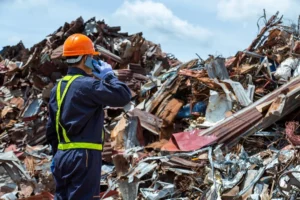Sustainability has become an underlying philosophy as people attempt to leave less of a footprint on the world around them. Recycling is a key component in any sustainable model for living, as it allows materials to be reused many times over, decreasing the need for additional mining and keeping precious materials in the supply chain. Metal is one of the leading materials singled out for recycling programs because mining metals can be damaging to the environment. But high volumes of metal are needed to power modern life.
Most people believe that metal recycling amounts to separating aluminum cans and dropping them in a recycling bin. However, there’s a bigger world of metal recycling for anyone willing to engage in the collection and reprocessing of scrap metal. For those who’ve never been involved with large-scale metal recycling, the process may seem daunting.
However, through the process of metal scrap disposal, anyone can contribute raw materials into the recycling chain and keep mining and energy usage to a minimum. Read on to learn what happens once a metal scrap buyer in Chase, MI, collects your scrap.
Collection
The chain of scrap metal recycling begins with collection by a metal scrap pick-up service that will not only help you dispose of unwanted scrap, but also provide it to industries that will put it back into use. Because metal has a higher scrap value than many other recyclable materials, there is an increasing demand for metal scrap in the form of junked automobiles, construction waste, industrial scrap, and consumer scrap.
Sorting
 Once your scrap metal is collected and deposited at a local scrap yard, it must be sorted. Scrap metal is usually categorized as ferrous or non-ferrous. Metals such as iron and steel are considered ferrous because of their iron content. Non-ferrous metals, such as copper, zinc, aluminum, stainless steel, and lead, have little to no iron content and are primarily comprised of other metals.
Once your scrap metal is collected and deposited at a local scrap yard, it must be sorted. Scrap metal is usually categorized as ferrous or non-ferrous. Metals such as iron and steel are considered ferrous because of their iron content. Non-ferrous metals, such as copper, zinc, aluminum, stainless steel, and lead, have little to no iron content and are primarily comprised of other metals.
Metals are initially separated using magnets, since ferrous metals are magnetic but non-ferrous metals are not. The metal is sorted further according to type by sensors that can help separate metals from one another, though some sorting processes rely on the human eye to discern metal type. Finally, metals may be further segregated by condition, as clean metals may command a higher value than their dirty or rusty counterparts.
Processing
To expedite processing, metals are shredded after sorting. Shredded metals will melt more easily and more smoothly than large chunks. That’s an important consideration because shreds also require less energy to melt, which can further reduce the impact of recycling on the environment. Metals are shredded into different forms depending on type. For example, iron and steel will usually be converted into small blocks, while aluminum is processed into thin sheets.
Melting
Melting is accomplished in large furnaces that are segregated by metal type. There are separate furnaces for each type of metal because metals have varying melting points and have varying furnace requirements. Melting usually takes minutes to hours depending on the metal being melted. Though a great deal of energy is used to power the furnaces, it’s still more efficient than melting newly mined metals.
Purification
 While melting begins the purification process, most metals require additional purification to render metals of desired content. In most cases, metals are purified through the process of electrolysis. The process involves using the desired metal as the anode and a thin sheet of metal as the cathode. Both components are placed in an electrolytic cell filled with salt and electric current is applied. Then, pure metal is deposited on the cathode and can be recovered.
While melting begins the purification process, most metals require additional purification to render metals of desired content. In most cases, metals are purified through the process of electrolysis. The process involves using the desired metal as the anode and a thin sheet of metal as the cathode. Both components are placed in an electrolytic cell filled with salt and electric current is applied. Then, pure metal is deposited on the cathode and can be recovered.
Cooling and Transport
Once the purification process is complete, the metal is shaped into bars, sheets, or ingots and allowed to cool to solid on a conveyor belt. Once cooled, the metals are easily transportable, and can be shipped to industries for use in new products.
Recycling scrap metal provides an excellent way to fulfill the continuing demand for metal used in industry and manufacturing. To learn more about the scrap metal recycling process, contact Fair Salvage Company at (989) 386-7552.

